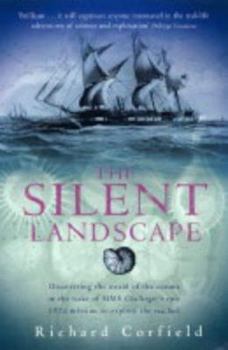The Silent Landscape : In the Wake of Hms 'Challenger' 1872-1876
Select Format
Select Condition 
Book Overview
In 1872 HMS Challenger set sail from Portsmouth, England, to map and sample the ocean floor. This marked the birth of modern oceanography. By retracing Challenger's extraordinary voyage, we view our... This description may be from another edition of this product.
Format:Paperback
Language:English
ISBN:0719565316
ISBN13:9780719565311
Release Date:January 2005
Publisher:John Murray Publishers Ltd
Length:304 Pages
Weight:0.40 lbs.
Dimensions:7.8" x 0.7" x 5.0"
Customer Reviews
3 ratings
Excellent
Published by Thriftbooks.com User , 20 years ago
For the most part, I'm a reader of fiction. As a student, I read so much non-fiction as part of daily life that I really seek an escape when it comes to my private time. So, when Richard Corfield came to speak at the University of Washington, I wasn't expecting to spend the next several days pouring over his book. "The Silent Landscape" outlines the voyage of the HMS Challenger, one of the most important sea voyages to date. Not only does Corfield outline the voyage, he stops along the way, and punctuates the discoveries of the Challenger crew with brilliant descriptions of the technology used at the time, the personal trials undertaken by the crew, and the conditions of life aboard the ship. Students of oceanography will no doubt be familiar with the Challenger. Anyone with even the remotests interest in the subject would do well to read this book. Not only informative, Corfield's writing style is pleasant and the layout of the work economical and extremely well done.
Traversing three and a half years and 69,000 nautical miles
Published by Thriftbooks.com User , 21 years ago
The Silent Landscape: The Scientific Voyage Of HMS Challenger by Oxford University based earth scientist and science writer Richard Corfield is the true and inherently fascinating story of one boat's 1872 journey and mission to map and sample the ocean floor. This was the first nautical voyage dedicated exclusively to oceanic science. Traversing three and a half years and 69,000 nautical miles, the members of the expedition suffered from suffocating tropical heat to extreme arctic cold. The HMS Challenger and its crew endured hardships and made history in its seminal and ground breaking contributions to human knowledge. A most amazing and engaging true story, The Silent Landscape is a welcome and enthusiastically recommended contribution to academic 19th Century Science History reference collections and supplemental reading lists.
The Start of Oceanographic Endeavor
Published by Thriftbooks.com User , 21 years ago
Probably the most famous scientific sea voyage was that of Charles Darwin in the _Beagle_ from 1831 to 1836. Darwin's findings, after many years of cogitation and hesitation, were the foundation of his _Origin of Species_, but the _Beagle_'s voyage was not one primarily dedicated to science. It was by a naval ship bound for exploration but also for territorial annexation. From 1872 to 1876, however, HMS _Challenger_ circumnavigated the globe for no purpose other than getting scientific information, especially about the sea. In _The Silent Landscape: The Scientific Voyage of HMS Challenger_, Richard Corfield has told the story of this remarkable voyage, but has also taken extraordinary leaps into the science the voyage sparked well into our current century. It is an inspiring story of the importance of pure science._Challenger_ was originally a warship, but for its new endeavor, most of its guns were removed to make way for laboratories. The corvette was changed to the first scientific exploration vessel the world had seen. It was a ship on the cusp, with both sails and steam. There was a naval staff to run the ship and the sounding and dredging apparatus, and also the "scientifics," the boffins who were to make the scientific investigation and documentation. There are many first findings reported here, like the "manganese nodules" (which are composed of more than manganese), balls of metallic rock which litter the sea floor like potatoes. The way such stones are formed is still a matter of dispute, but they are of serious interest now to oceanic mining conglomerates. Professor Corfield has told the story of the voyage in sequence, but, as with his section on plate tectonics, he frequently jumps ahead for a century to tell what has been found since the _Challenger_. Just when the reader might be close to an overdose of scientific detail, Corfield lightens the story with quotations from the journals of the members of the crew to reflect on the danger or the tedium of the work.The official report of the voyage of the _Challenger_ occupied 50 volumes, the last published in 1895. Corfield explains that the voyage laid the foundations for current theories of climate change, global warming, continental drift, and much more. "Its importance can hardly be exaggerated," he says, and part of the appeal of this volume is that _Challenger_'s legacy of discoveries in the twentieth century are so well laid out. But Corfield stresses also that _Challenger_ was a milestone in the history of humanity, a first voyage for knowledge for its own sake. One of the most appealing characteristics of our species, the quest for satisfaction of curiosity, was manifest on this first voyage. It was the start of a grand tradition of oceanic and aerospace exploration.





